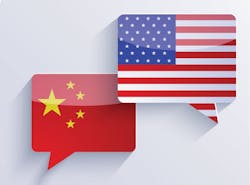The talks come on the heels of an increase in the tariff rate.
The initial tariffs started at 10 percent when they were originally levied in September 2018, but climbed to 25 percent starting on Jan. 1, 2019.
The U.S. government is asking China to buy more American products and stop requiring U.S. companies to give up proprietary technology in exchange for participating in the Chinese market, according to NPR correspondent Rob Schmitz.
If China concedes these two points, the U.S. will eliminate the tariffs.
The list of goods subject to the newest tariffs includes these common facilities products:
- Disinfectants
- Pesticides, insecticides, fungicides and rodenticides
- Fly ribbons
- Flexible plastic tubes, pipes and hoses
- Vinyl tile and other vinyl flooring
- Carpets and textile-based flooring
- Plastic bidets, lavatory pans, flushing cisterns and other sanitary ware
- Plastic “builders’ ware”
- Natural rubber, including latex
- EPDM
- More than 10 species of wood in raw and partially finished forms
- Oriented strand board and particle board
- Cork
- Bamboo, including floor coverings and screens
- Toilet paper
- Cotton and wool products
- Copper, aluminum, steel and tin
- Equipment and parts for air conditioners, refrigerators, freezers, humidifiers/dehumidifiers, and heat pumps
- Office machines
- Evaporative air coolers
- Floor polishers and carpet sweepers
- Wood and metal furniture
- Electric lamps and lighting fixtures, including LED lighting components
Without an end to the tariffs, these items will likely increase in price, which means that facilities professionals stocking up on certain products will pay more for them.
Help BUILDINGS Shape 2019!
What BUILDINGS resources are most valuable to you? What would you like to see us provide?
Please take our short (under 2 minutes) survey - just 5 short questions.
Thank you!
Many manufacturers attempted to absorb at least some of the increase in materials prices, explains Mike Watson, vice president and general manager of e-conolight, which manufactures LED lighting products.
However, as manufacturers use up their existing stocks of components and customers purchase lighting inventory that was built before the tariffs took effect, the increase will become more prominent.
“You’ll see a three- to six-month latency in price increases that isn’t coincident with the actual tariffs,” Watson says. “For example, we front end increased our inventory levels because a 10 percent tariff is better than a 25 percent tariff. Manufacturers who were more proactive are going to win in that case. Large price increases also tend to be disruptive and slow down business, so you'll start seeing gradual price increases rather than steep ones. Over time, the cost of that 25 percent has to be borne by either cost reduction on the supply side or price increases on the manufacturer’s side.”
The rising prices will especially affect facilities that need lamps and lighting fixtures that aren’t made of base metal, which topped $1.94 billion in imports from China last year, and certain kinds of furniture (mainly wood and metal).
Facilities professionals who have the authority to specify products should work closely with vendors to make sure they're specifying products based on performance (rather than a particular manufacturer or product) and aren't being charged extra for untariffed products, Watson recommends.
“There are still some products that aren’t tariffed. Lamps and downlights are not on the current list of tariffs,” says Watson. “If a contractor gives you a quote and they have a tariff applied to a lamp or downlight, they might just be trying to make more money. Look at what’s included in the tariff list and know what's not included to make sure you’re not taken advantage of.”
Previous tariffs introduced in March 2018 targeted steel and aluminum imports and resulted in retaliatory tariffs from a number of countries affected by the policy, including longtime allies Canada and the European Union.
This article was originally published on Sept. 24, 2018. It was updated on Jan. 7, 2019.
Two handpicked articles to read next:
About the Author
Janelle Penny
Editor-in-Chief at BUILDINGS
Janelle Penny has been with BUILDINGS since 2010. She is a two-time FOLIO: Eddie award winner who aims to deliver practical, actionable content for building owners and facilities professionals.


